International Trade and Public Policy is a crucial topic within AP Microeconomics, exploring how countries engage in the exchange of goods and services. It examines the principles of comparative advantage, the benefits and costs of trade, and various government interventions such as tariffs, quotas, and subsidies. Understanding these concepts helps students analyze how trade policies affect domestic markets, consumer welfare, and overall economic efficiency, equipping them with the knowledge to excel in their AP Microeconomics exam.
Free AP Microeconomics Practice Test
Learning Objectives
When studying International Trade and Public Policy for AP Microeconomics, you should focus on understanding the principles of absolute and comparative advantage, and how they drive trade between nations. Learn to analyze the benefits and costs of trade, including gains from specialization and potential trade-offs. Examine various trade policies such as tariffs, quotas, and subsidies, and their effects on consumers, producers, and overall economic welfare. Additionally, explore trade agreements and economic integration, and develop skills to evaluate the impact of these policies using supply and demand diagrams. Mastering these objectives will equip you to effectively tackle related exam questions.
1. Introduction to International Trade
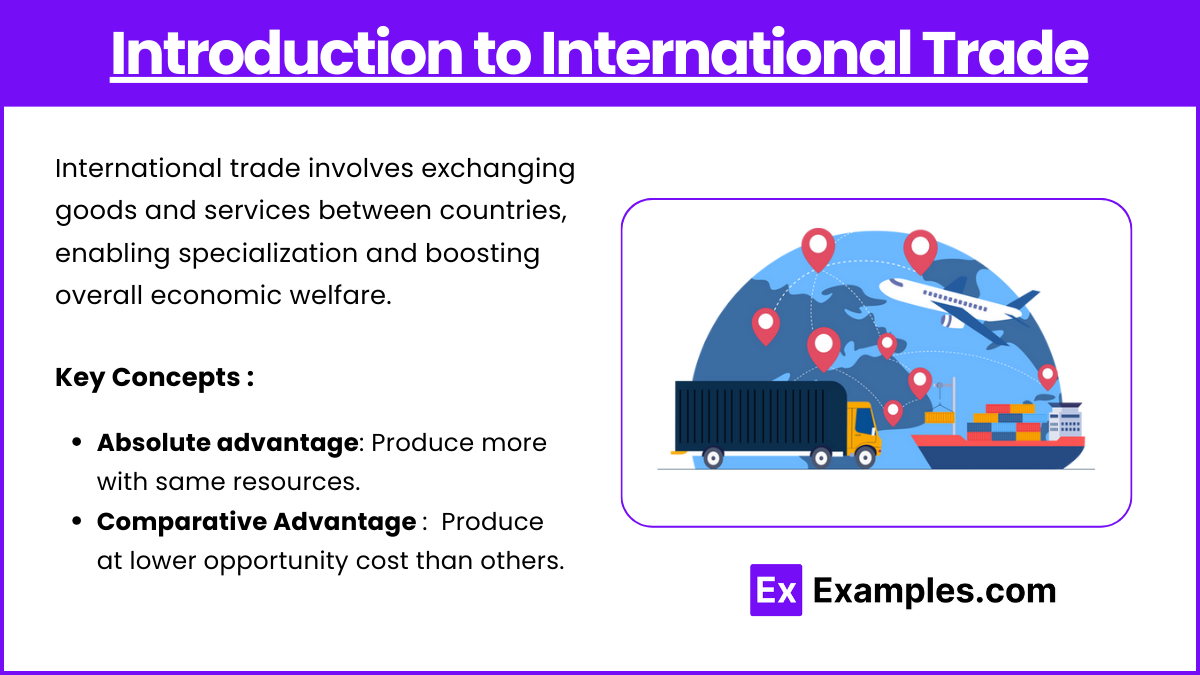
International Trade refers to the exchange of goods and services between countries. It allows nations to specialize in producing goods where they have a comparative advantage, leading to increased overall economic welfare.
Key Concepts:
Absolute Advantage: When a country can produce more of a good using the same resources as another country.
Comparative Advantage: When a country can produce a good at a lower opportunity cost compared to another country. This is the cornerstone of international trade theory.
Example:
Country A can produce 10 cars or 5 computers.
Country B can produce 6 cars or 6 computers.
Absolute Advantage: Country A has an absolute advantage in producing cars and computers.
Comparative Advantage:
Country A’s opportunity cost of 1 car = 0.5 computers.
Country B’s opportunity cost of 1 car = 1 computer.
Country A has a comparative advantage in producing cars.
Country B has a comparative advantage in producing computers.
2. Gains from Trade
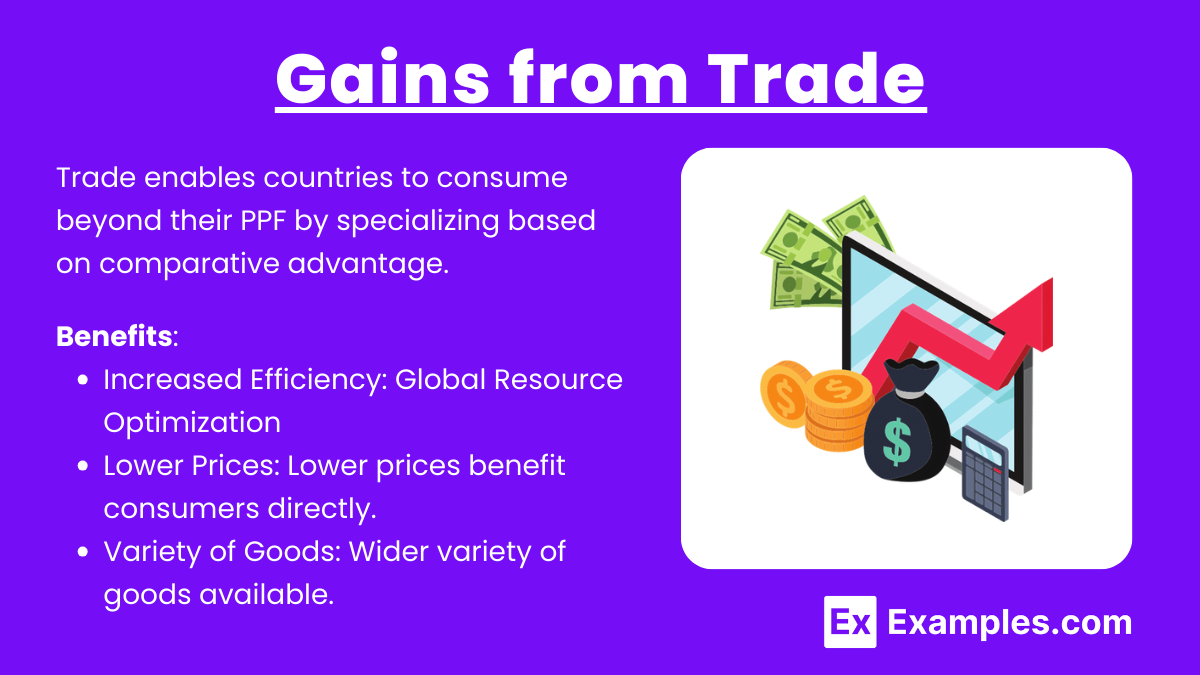
Trade allows countries to consume beyond their production possibilities frontier (PPF). The gains from trade arise because each country specializes in producing goods where they have a comparative advantage and then trades for other goods.
Benefits:
Increased Efficiency: Resources are allocated more effectively globally.
Lower Prices: Consumers benefit from lower prices due to increased competition and specialization.
Variety of Goods: Consumers have access to a wider variety of goods and services.
Graphical Representation:
Production Possibility Frontier (PPF): Shows the maximum possible output combinations of two goods.
Autarky: A situation where a country does not trade.
Trade: Allows the country to consume beyond its PPF.
3. Terms of Trade
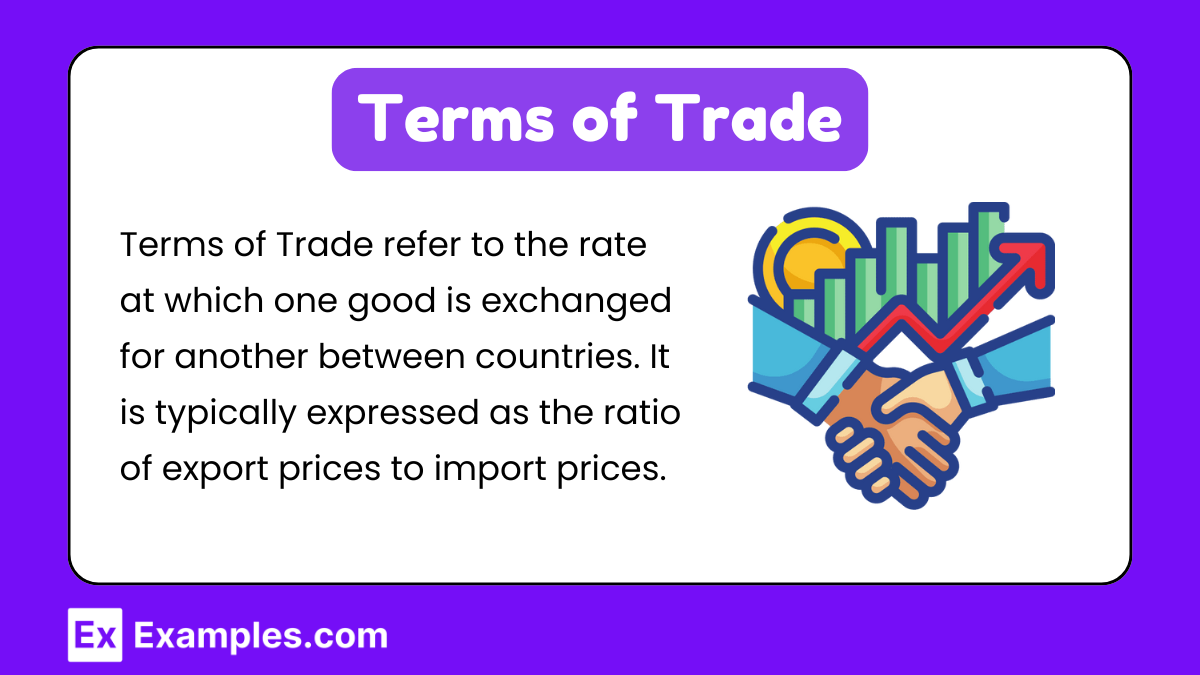
Terms of Trade refer to the rate at which one good is exchanged for another between countries. It is typically expressed as the ratio of export prices to import prices.
Improvement in Terms of Trade:
Occurs when a country can obtain more imports for a given level of exports. An improvement in the terms of trade occurs when a country's export prices rise relative to its import prices, allowing it to obtain more imports for a given amount of exports. This enhances the country's purchasing power and can lead to increased national welfare.
Graphical Analysis:
Autarky Price Ratio: The ratio of goods without trade.
Trade Price Ratio: The exchange rate when trade occurs, lying between the two countries' opportunity costs.
4. Trade Restrictions and Their Effects
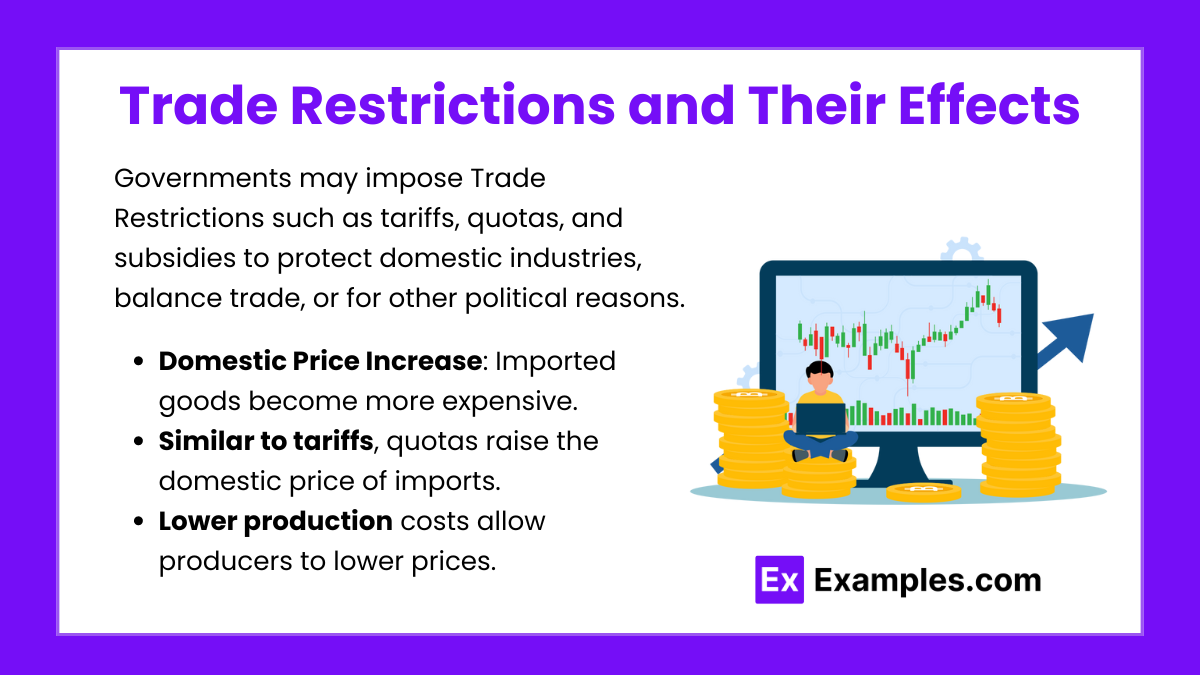
Governments may impose Trade Restrictions such as tariffs, quotas, and subsidies to protect domestic industries, balance trade, or for other political reasons. While these policies can benefit certain groups, they often lead to overall economic inefficiency.
A. Tariffs
Definition: A tax on imported goods.
Effects:
Domestic Price Increase: Imported goods become more expensive.
Consumer Surplus Decreases: Consumers pay higher prices and consume less.
Producer Surplus Increases: Domestic producers can sell more at higher prices.
Government Revenue: Gains from tariff taxes.
Deadweight Loss: Loss of economic efficiency due to reduced trade.
B. Quotas
Definition: A limit on the quantity of a good that can be imported.
Effects:
Similar to tariffs, quotas raise the domestic price of imports.
Producer Surplus: Increases as domestic producers can charge higher prices.
Consumer Surplus: Decreases due to higher prices and reduced availability.
Deadweight Loss: Exists because some beneficial trades are not occurring.
C. Subsidies
Definition: Financial assistance to domestic producers.
Effects:
Domestic Price Decreases: Lower production costs allow producers to lower prices.
Consumer Surplus Increases: Consumers pay lower prices.
Producer Surplus Increases: Producers receive higher effective prices.
Government Cost: Subsidies require government spending.
Deadweight Loss: Often present due to overproduction and misallocation of resources.
D. Comparative Analysis: Tariffs vs. Quotas
Revenue Allocation: Tariffs generate revenue for the government, while quotas create scarcity without direct revenue.
Market Impact: Both distort market equilibrium, but the specific effects can vary based on demand and supply elasticity.
5. Public Policy Objectives in Trade
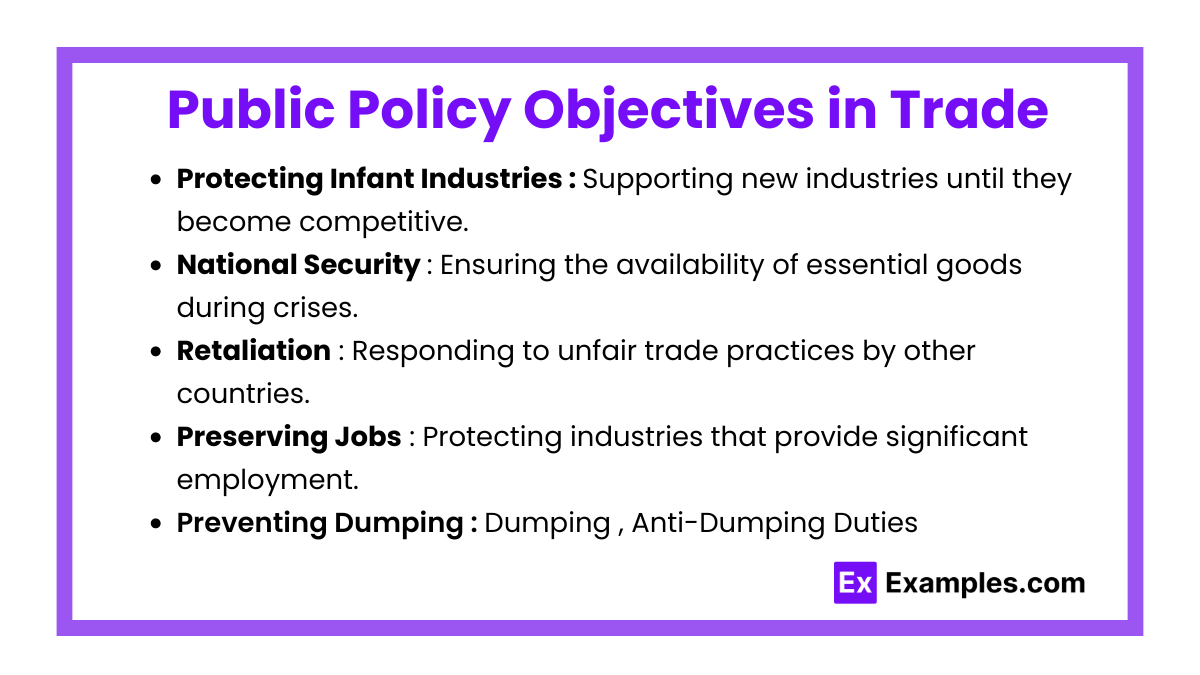
Governments implement trade policies to achieve various objectives that align with their economic, social, and political goals. These policies can influence domestic industries, consumers, and the overall economy. Understanding these objectives is crucial for analyzing trade policies and their impacts.
Protecting Infant Industries : Supporting new industries until they become competitive.
National Security : Ensuring the availability of essential goods during crises.
Retaliation : Responding to unfair trade practices by other countries.
Preserving Jobs : Protecting industries that provide significant employment.
Preventing Dumping
Dumping: Selling goods in a foreign market at below cost to eliminate competition.
Anti-Dumping Duties: Tariffs imposed to counteract dumping practices.
Examples
Example 1. U.S.-China Trade War
The U.S.-China Trade War is a prominent example of international trade and public policy in action. Initiated in 2018, the United States imposed tariffs on billions of dollars’ worth of Chinese goods, aiming to reduce the trade deficit and protect American industries from what it considered unfair trade practices, such as intellectual property theft and forced technology transfers. In response, China retaliated with its own tariffs on U.S. products. This tit-for-tat escalation affected a wide range of industries, including agriculture, manufacturing, and technology. The trade war led to increased prices for consumers, disruptions in global supply chains, and uncertainty in international markets. It also prompted both countries to engage in negotiations to address underlying trade issues, highlighting the complex interplay between national policies and global economic relations.
Examnple 2. European Union (EU) Single Market and Customs Union
The European Union (EU) exemplifies a high level of economic integration through its Single Market and Customs Union. The Single Market allows for the free movement of goods, services, capital, and labor among the 27 member states, eliminating tariffs and reducing regulatory barriers. Additionally, the Customs Union ensures that all member countries apply the same external tariffs on imports from non-EU countries. This integration facilitates seamless trade within the EU, promotes competition, and enhances economic efficiency by allowing businesses to operate across borders without facing additional costs. However, it also requires member states to harmonize their trade policies and adhere to common regulations, which can limit national policy flexibility. The EU’s trade policies and agreements with external countries are managed collectively, reinforcing the bloc’s negotiating power on the global stage.
Example 3. U.S. Agricultural Subsidies
The United States government provides substantial subsidies to its agricultural sector, a key aspect of its public policy influencing international trade. These subsidies help stabilize farmers’ incomes, encourage production, and ensure a steady supply of food. However, they also have significant implications for global markets. By lowering production costs, U.S. agricultural products can be sold at lower prices internationally, making it challenging for farmers in developing countries to compete. This can lead to trade tensions and disputes within organizations like the World Trade Organization (WTO). Additionally, subsidies can contribute to overproduction and environmental degradation. While they support the domestic agricultural industry, U.S. subsidies are often criticized for distorting global trade and disadvantaging producers in less-developed economies.
Example 4. Anti-Dumping Duties on Steel Imports
Anti-dumping duties are tariffs imposed to protect domestic industries from foreign companies selling products below cost, a practice known as dumping. A relevant example is the imposition of anti-dumping duties on steel imports by various countries, including the United States and members of the European Union. When domestic steel producers allege that foreign competitors are dumping steel at unfairly low prices, governments may impose additional tariffs to level the playing field. These duties aim to prevent the undercutting of local industries, preserve jobs, and ensure fair competition. However, they can also lead to higher prices for consumers and industries that rely on steel, potentially sparking retaliatory measures from trading partners. The use of anti-dumping duties illustrates the balance governments seek between protecting domestic industries and maintaining open, fair international trade.
Example 5. United States-Mexico-Canada Agreement (USMCA)
The United States-Mexico-Canada Agreement (USMCA) is a modern example of a trade agreement that replaces the earlier North American Free Trade Agreement (NAFTA). Signed in 2020, the USMCA aims to create a more balanced and reciprocal trade environment among the three countries. It includes provisions on digital trade, intellectual property, labor rights, and environmental standards, reflecting contemporary economic concerns. For instance, the agreement enhances protections for U.S. intellectual property and ensures better labor standards in Mexico, which can lead to improved wages and working conditions. Additionally, the USMCA modifies automotive rules of origin to encourage more manufacturing within North America. By reducing tariffs and simplifying trade regulations, the USMCA seeks to boost economic growth, increase trade flows, and strengthen economic ties among the member countries. However, it also requires member states to adhere to stricter standards, which can involve significant policy adjustments.
Multiple Choice Questions
Question 1
Which of the following best illustrates the concept of comparative advantage?
A) Country A can produce 10 tons of wheat or 5 tons of rice, while Country B can produce 6 tons of wheat or 6 tons of rice. Country A should specialize in producing wheat, and Country B should specialize in producing rice.
B) Country A can produce 10 tons of wheat or 5 tons of rice, while Country B can produce 6 tons of wheat or 6 tons of rice. Both countries should produce both goods and engage in trade.
C) Country A has an absolute advantage in producing both wheat and rice compared to Country B, so it should produce both goods and export them.
D) Country A and Country B have the same opportunity costs for producing wheat and rice, so there is no benefit from trade.
Answer: A
Explanation: Comparative advantage occurs when a country can produce a good at a lower opportunity cost compared to another country. It is the foundation for beneficial trade between nations.
Let's analyze the options:
Option A:
Country A:
Opportunity cost of 1 ton of wheat = 0.5 tons of rice (5 tons of rice / 10 tons of wheat).
Country B:
Opportunity cost of 1 ton of wheat = 1 ton of rice (6 tons of rice / 6 tons of wheat).
Comparative Advantage:
Country A has a lower opportunity cost for producing wheat (0.5 < 1).
Country B has a lower opportunity cost for producing rice (since Country A's opportunity cost for rice is higher).
Conclusion: Country A should specialize in wheat, and Country B in rice, maximizing gains from trade.
Option B:
While both countries engaging in trade can be beneficial, this option does not specifically address comparative advantage, which dictates specialization based on lower opportunity costs.
Option C:
Absolute advantage refers to the ability to produce more of a good with the same resources. However, having an absolute advantage in both goods does not necessarily mean that specialization based on comparative advantage won't yield gains from trade.
Option D:
If both countries have the same opportunity costs, there is no comparative advantage, and thus no inherent benefit from trade based on this concept.
Therefore, Option A correctly illustrates comparative advantage by showing how each country benefits from specializing in the good for which it has a lower opportunity cost.
Question 2
A government imposes a tariff on imported cars. Which of the following is a likely consequence of this policy?
A) Consumer surplus increases while producer surplus decreases.
B) Producer surplus increases and government revenue increases, but consumer surplus decreases.
C) Both consumer surplus and producer surplus increase, leading to a net gain in economic welfare.
D) Government revenue decreases and there is no change in producer or consumer surplus.
Answer: B
Explanation: When a tariff (a tax on imported goods) is imposed, it affects the market in several ways:
Price of Imported Cars Increases: The tariff makes imported cars more expensive.
Domestic Consumers Pay Higher Prices: As a result, the quantity of imported cars demanded decreases.
Domestic Producers Benefit: Domestic car manufacturers can sell more cars at higher prices because the competition from cheaper imports is reduced.
Government Gains Revenue: The government collects revenue from the tariff imposed on each imported car.
Consumer Surplus Decreases: Consumers either pay higher prices or switch to buying fewer cars, reducing their overall welfare.
Deadweight Loss: There is an inefficiency in the market because the tariff distorts the equilibrium, leading to a loss in total welfare that is not offset by any gains.
Analyzing the options:
Option A: Incorrect. Consumer surplus decreases, and producer surplus increases.
Option B: Correct. Producer surplus increases due to higher prices and greater sales, government revenue increases from the tariff, and consumer surplus decreases because consumers pay more and consume less.
Option C: Incorrect. While producer surplus and government revenue increase, consumer surplus decreases, leading to a net loss in economic welfare, not a gain.
Option D: Incorrect. Government revenue increases, and both producer and consumer surplus are affected.
Thus, Option B accurately describes the consequences of imposing a tariff on imported cars.
Question 3
Which of the following scenarios best exemplifies the concept of "trade diversion" as a result of a trade agreement?
A) Country X reduces tariffs on all its trading partners, leading to an overall increase in international trade.
B) Country Y enters a free trade agreement with Country Z, leading to increased imports from Country Z and a decrease in imports from a non-member Country W, even though W could produce the goods more efficiently.
C) Country A imposes quotas on imported textiles to protect its domestic textile industry from foreign competition.
D) Country B subsidizes its agricultural sector, making its exports cheaper on the global market and increasing its market share.
Answer: B
Explanation: Trade diversion occurs when a country enters a free trade agreement (FTA) or a customs union, leading it to import goods from a less efficient member country instead of a more efficient non-member country because of the preferential treatment within the agreement.
Let's evaluate each option:
Option A:
This scenario describes trade creation, where reducing tariffs leads to increased trade efficiency and welfare by allowing trade with more efficient partners.
Option B:
Explanation:
Country Y forms an FTA with Country Z, eliminating tariffs between them.
Country W is not part of the FTA but can produce the same goods more efficiently (lower cost).
Despite Country W's efficiency, Country Y imports from Country Z because of the tariff advantages within the FTA.
This is trade diversion, as imports shift from the more efficient Country W to the less efficient Country Z due to the trade agreement.
Option C:
Imposing quotas is a form of trade restriction but does not specifically relate to trade diversion resulting from an FTA.
Option D:
Subsidizing exports affects competitive pricing but does not directly involve shifting trade away from more efficient producers to less efficient ones within a trade agreement framework.
Therefore, Option B correctly illustrates trade diversion by showing how a free trade agreement can lead to importing from a less efficient member country instead of a more efficient non-member country.

